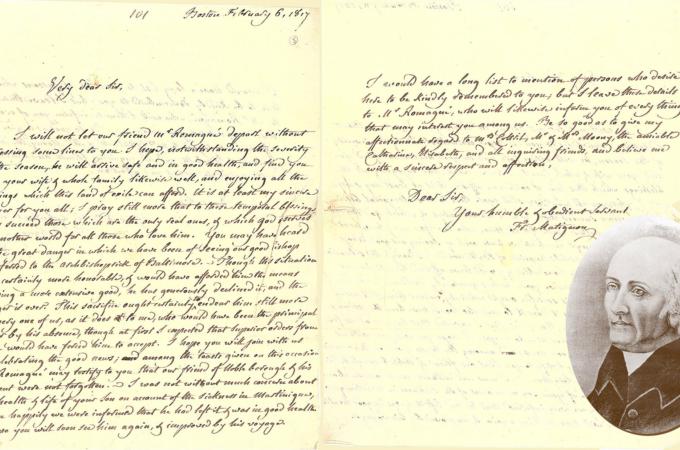Matignon letter gives insight into early archdiocese
A letter dated Feb. 6, 1817 from Father Francis Matignon to Matthew Cottrill, while brief, indicates much about the Diocese of Boston at the time.
Father Matignon was one of the two priests credited with laying the foundations of the Archdiocese of Boston in the late-18th and early 19th Century. It was he who invited his friend, the then Father John Cheverus, to come to Boston and help him serve the Catholic community here, and who would advocate for Father Cheverus to be named the first Bishop of Boston.
The Cottrill family, along with the Kavanaghs, Hanleys, and Jacksons, are recognized as the first Catholic families to have settled in what is now Maine. They would have been well acquainted since at least 1793, as records show that Cottrill and his business partner, John Kavanagh, made contributions to the upkeep of the church at that time. The following year, on June 16, 1794, Father Matignon celebrated the marriage of Matthew Cottrill and his wife, Lydia House, in Boston.
In his letter, Matignon writes that Father James Romagne was on his way to Nobleboro, Maine to see the Cottrill family, among others, and that he could not let him "depart without addressing some lines to you." What is striking about this statement, keeping in mind the date on which the letter was composed, is that priests were venturing out from Boston mid-winter to tend to their flock.
Throughout the early 19th century, there was a constant shortage of priests to attend to the Catholic population of New England. To send a priest to Cottrill's "land of exile" in early February shows an admirable determination to fulfill their duty despite the numerous hardships they faced. Father Matignon continues with the hope that "notwithstanding the severity of the season, he (Father Romagne) will arrive safe and in good health."
Father Matignon also makes mention of an event which could have altered the early history of the diocese significantly, and that is the offer of Bishop Cheverus to succeed Archbishop Leonard Neale, S.J., as the Archbishop of Baltimore. This most likely refers to him being named coadjutor, as Archbishop Neale would continue to serve until his passing later that year, on June 18, 1817.
Matignon expresses much relief that his good friend would not be departing. He writes, "you may have heard of the great danger in which we have been of seeing our good Bishop transferred to the archbishoprick of Baltimore. Though this situation was certainly more honorable, and would have afforded him the means of doing a more extensive good, he has generously declined it, and the danger is over. This sacrifice ought certainly to endear him still more to every one of us, as it does to me, who would have been the principal looser (sic.) by his absence."
Sadly, Father Matignon would pass away the following year, in September 1818. Few treasured pieces of his correspondence remain, so it is difficult to elaborate upon this small glimpse into his relationship with the Cottrill family. The "History of the Archdiocese of Boston" does reveal that the Cottrills, and the other early families in Maine, usually visited Boston at least once a year in the springtime. It is likely that they would have continued their relationship in person during those annual visits.
Bishop Cheverus would continue to serve as the Bishop of Boston for five more years, returning to his native France in 1823.
THOMAS LESTER IS THE ARCHIVIST OF THE ARCHDIOCESE OF BOSTON.



















